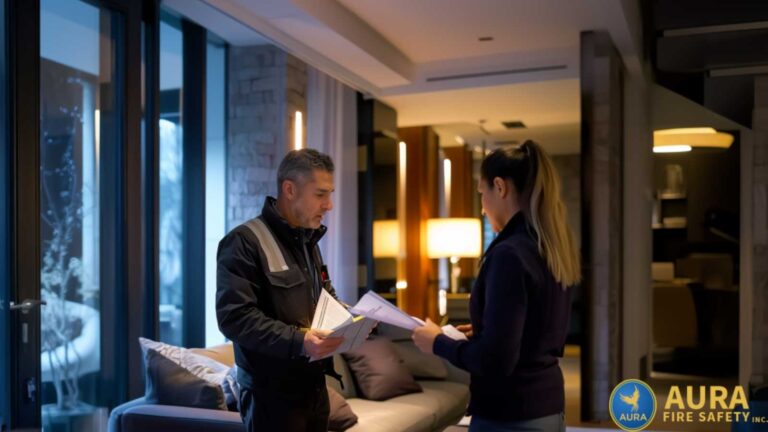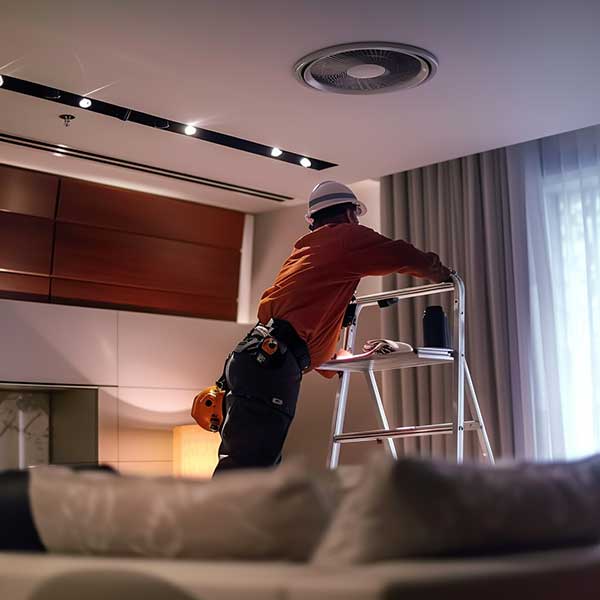San Francisco’s enforcement of fire safety regulations has intensified since July 1, 2023, underscoring the urgency for all property owners to comply. As the city enforces tougher penalties for lapses in fire safety measures, the responsibility to keep properties up-to-date has never been more critical. The official deadline may have passed, but the window to safeguard your property and avoid fines remains open. Immediate action is crucial.
Get in Touch for Fire Protection Services
Overview of San Francisco Fire Safety Regulations
Stringent fire safety regulations are a critical component of urban living in San Francisco, designed to protect residents from the dangers of fire. Property owners are required to adhere to these regulations, which are stringently enforced to mitigate risks and enhance the efficacy of emergency responses. Understanding and complying with these codes is not just a legal obligation but a fundamental aspect of responsible property management.
Current Codes for Fire Alarms in Residential Properties
The San Francisco Fire Department strictly requires fire alarm installation in all residential properties, emphasizing their placement in each bedroom or designated sleeping area—commonly referred to as the “pillow test.” This mandate aims to ensure that fire alarm sound levels are capable of awakening individuals during fire emergencies, increasing the chances of a safe and timely evacuation. Adhering to this requirement is vital, as it directly correlates with the potential to save lives and reduce property damage during fire incidents.
Consequences of Non-Compliance
Non-compliance with these essential fire safety regulations can lead to severe consequences for property owners. Penalties include substantial fines and possible legal actions, which can escalate to more severe sanctions depending on the degree of negligence observed. More importantly, failing to comply jeopardizes tenant safety, potentially leading to tragic outcomes in the event of a fire.
The Pillow Test Explained
The “pillow test” is a measure for evaluating the effectiveness of fire alarms in residential units. This segment explains the test’s importance in safeguarding residents during the night and provides detailed steps for property owners to ensure their fire alarms meet this vital safety standard.
What is the Pillow Test and Why is it Important?
The “pillow test” is a regulatory requirement that ensures the alarm sound from fire alarms is sufficiently loud to awaken individuals from sleep, providing essential reaction time during a fire. This test mandates that the sound level of the fire alarm must reach at least 75 dBA at the pillow level within each sleeping area. This is crucial for nighttime fire safety, as it ensures that all residents, regardless of their deep sleep phases, are promptly alerted to fire emergencies, thereby maximizing evacuation time and safety.
- Scope and Applicability: The pillow test applies to all existing (R-2) residential buildings with three units or more equipped with an existing building fire alarm system.
- Sound Level Criteria: To pass the pillow test, audible appliances must emit a sound of at least 75 dBA, or 15 dB above the average ambient sound level, or 5 dB above the maximum sound level having a duration of at least 60 seconds—whichever is greater, measured at the pillow level in the sleeping area.
- Barrier Considerations: If barriers like doors or curtains are present between the alarm and the pillow, the sound pressure must be tested with the barrier in place to ensure it still meets the required levels.
- Frequency Requirements: From January 1, 2014, new installations must produce a low-frequency alarm signal (520 Hz) to effectively awaken sleepers, although existing systems that meet the dB requirements are acceptable even without this frequency.
This rigorous testing is designed not merely as a regulatory hurdle but as a crucial life-saving measure. It underscores the importance of ensuring that every resident can be quickly alerted to fires, irrespective of where they sleep within the home.
Alternative Compliance Process: Option 2 for Meeting the Pillow Test Requirements
If a property does not meet the requirements under Option 1—where documentation of previously approved fire alarm inspection is provided—Option 2 offers a structured pathway to verify and achieve compliance with the pillow test requirements. This alternative approach ensures that all properties, regardless of their initial status, can align with San Francisco’s stringent safety standards.
- Conducting an Audibility Test: The first step under Option 2 is to perform an audibility test by a licensed C-10 contractor to ensure they meet the minimum requirements or the specified dB levels above ambient sound.
- Documentation and Reporting: The results of this audibility test must be documented in a detailed report by the contractor on official letterhead. This report should include the date of the test, a statement confirming the use of a calibrated and approved dBA meter, and the actual dBA readings for each sleeping area.
- Submission and Verification: The completed report must be submitted to the San Francisco Fire Department (SFFD) along with a $1.00 Fire Only permit application. The permit’s scope should explicitly state “To verify existing sound levels in sleeping areas, complying with SFFC Section 1103.7.6.1.”
Following the submission, a random sampling inspection is conducted by a District Fire Inspector to verify the sound levels documented in the report. The contractor responsible for the audibility measurements must be present during this inspection with the calibrated dBA meter used for the initial testing.
This alternative compliance process is crucial for properties that initially lack the necessary documentation or whose existing systems do not conform to the required sound levels.
Steps to Ensure Your Property Passes the Pillow Test
Ensuring that your property passes the “pillow test” involves several critical steps aimed at optimizing the functionality and effectiveness of your fire alarm:
- Evaluate and Test Each Device: Conduct thorough evaluations and audibility tests on each fire alarm to ensure they function correctly and are loud enough to meet the pillow test requirements.
- Address Barriers: Conduct tests considering any barriers that might impede the sound. Ensure that the sound level is adequate even with doors closed or other potential obstructions.
- Upgrade Older Systems: Replace outdated or non-compliant fire alarm systems to meet current code standards. This update is crucial for older buildings that may have systems not originally designed to meet these stringent requirements.
- Regular Audibility Checks: Implement a routine schedule for checking the audibility of your fire alarm. This ongoing compliance ensures that all units maintain their effectiveness and are capable of performing during an emergency.
Property owners in San Francisco can ensure their properties meet rigorous fire safety regulations by meticulously following these guidelines and regularly assessing the condition and effectiveness of fire alarms.
Get in Touch for Fire Protection Services
Compliance Deadlines and Urgency to Act
The primary deadline for San Francisco property owners to upgrade their fire alarm systems was July 1, 2023. This deadline was set to ensure that all residential properties are equipped with fire alarms that meet the latest safety standards, including the ability to wake sleeping individuals with sufficient sound levels during emergencies.
What Happens if You Miss the Deadline?
If you’ve missed the July 1, 2023 deadline, the San Francisco Fire Marshal’s office is likely to take stringent enforcement actions. Here’s a detailed guide on what steps to take if you find your property non-compliant:
- Conduct a Detailed System Audit: Review your current fire alarm design comprehensively to identify any aspects that do not meet the NFPA 72-2013 requirements or the specific stipulations of the San Francisco Fire Code Section 1103.7.6.1.
- Consult with Fire Safety Experts: Engage a licensed fire safety professional or firm to get an expert assessment of your system. They can provide guidance on necessary upgrades and help with system design that complies with local regulations.
- Secure and Submit Necessary Documentation:
-
- Proof of Previous Compliance (if applicable): Gather any previously approved and issued plans or fire inspection certifications. These documents should include the equipment list, sequence of operation matrix, and layout of devices in sleeping areas.
- Audibility Test Reports: If you haven’t met all documentation requirements, arrange for an audibility test by a licensed C-10 contractor.
- Apply for a Fire Only Permit: Submit the audibility test report and apply for a “$1.00 Fire Only” permit at the local fire department. This permit allows for the official verification of the sound levels in your property’s sleeping areas.
- Schedule an Inspection: Once you’ve submitted your report and obtained the necessary permits, contact the district fire inspector to arrange a site visit. The inspector will verify the sound levels as recorded in your audibility test report.
- Implement Recommended Upgrades: Based on the expert assessment and inspection results, implement the recommended system upgrades or installations. This may include installing low-frequency audible appliances or updating the fire alarm control unit (FACU).
By taking these specific actions promptly, you can mitigate the risks associated with non-compliance, including potential fines and legal consequences. Addressing any deficiencies in your fire safety measures without delay is crucial to safeguarding your property and its occupants.
Proactive Measures to Avoid Penalties
Ensuring compliance with fire safety regulations requires ongoing attention and proactive management. This section discusses essential measures property owners can take to avoid penalties, including regular inspections, maintenance, and system upgrades, which are pivotal in maintaining the integrity and effectiveness of fire safety measures.
Regular Inspections and Maintenance
Continuous compliance and operational effectiveness of fire safety systems hinge on regular inspections and diligent maintenance. Certified professionals should periodically inspect all fire alarms to identify potential malfunctions or inefficiencies early.
Maintaining detailed records of all inspections, maintenance, and any repairs done on fire safety equipment is crucial. These records serve as proof of compliance and can be instrumental during inspections by fire safety officials or in the event of an insurance claim.
Upgrading Your Fire Alarm System
Technological advancements have made modern fire alarm systems more reliable and compliant with current fire safety standards. Property owners should consider upgrading to the latest models that provide broader coverage and enhanced detection capabilities. These systems are designed to meet stringent safety standards and may offer features such as wireless connectivity and integrated voice evacuation messages.
Collaborating with fire safety experts like Aura Fire Safety ensures that your property’s fire protection system is up-to-date and fully compliant. These professionals can provide tailored solutions that cater specifically to your property’s unique needs, ensuring that all areas are adequately protected.
How Aura Fire Safety Can Help
Aura Fire Safety ensures your property’s fire alarm system is fully compliant and functional, meeting San Francisco’s stringent fire codes. Licensed to perform critical decibel tests and equipped to upgrade systems where required, we manage the compliance process end-to-end. Choose enduring safety and reliability — contact Aura Fire Safety today!
Get in Touch for Fire Protection Services


